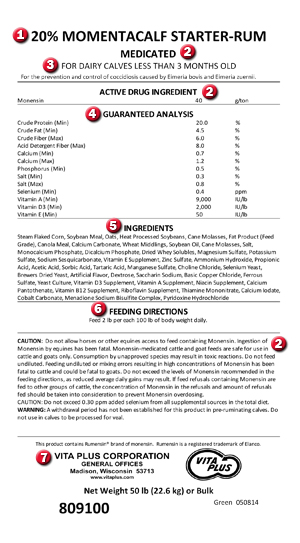
Ask the Expert: What Information is Found on a Feed Tag? – Dr. Al Schultz, Vita Plus
 By Dr. Al Schultz, Vita Plus vice president of technical services
By Dr. Al Schultz, Vita Plus vice president of technical services
Question: I want to have a good handle on what I’m feeding my calves, but feed tags can be difficult to understand. What am I looking at and what do all the terms mean?
A: Every bag of commercial feed that is manufactured must have a feed tag attached to it. If you purchase in bulk, you should receive a tag copy along with the bulk shipment. That is the law and the feed law dictates what information is required and how it must be displayed.
This means you should be able to look at any company’s feed tag and find the pertinent information in approximately the same place and presented in a generally uniform manner. Let’s take our texturized calf starter as an example.
 1. Product name
1. Product name
This is the name the manufacturer uses to identify the product. Feed companies often have hundreds of products, each with a different name. Sometimes, however, those name differences are very small, so be careful. For instance, the product shown here is “20% Momentacalf Starter-RUM.” We also manufacture “20% Momentacalf Starter-BOVA.” The two products are exactly the same except one is medicated with Rumensin® and the other contains Bovatec®.
Vita Plus uses abbreviations of the various medications in the name to draw attention to the medication and distinguish between alternatives.
Anytime you see a percentage in the name, it must reference the level of protein unless it specifically says otherwise.
2. Medication information
If a product contains medications, such as the tag illustrated here, several required pieces of information must be included on the tag:
- The word “medicated” right under the name in large enough print to bring attention to that inclusion
- A claim for the medication: Why is it added? Note, in this tag, the claim is for the prevention and control of coccidiosis; this exact verbiage is regulated by the U.S. Food and Drug Administration.
- A declaration of how much of the drug has been added
- Any cautions or warnings: These provide the customer with pertinent information concerning the drug. They should be read and understood. Of most importance may be a withdrawal time that must be observed to ensure no drug residues enter the food supply.
3. Purpose statement
This tells the customer for what species and animal classes the feed is formulated. This is especially important for any medicated feeds. (On the illustrated tag, this feed is “for calves less than 3 months old.”)
4. Guaranteed analysis
Certain guarantees are required; the manufacturer has the option to add other things as well. Most companies guarantee what is required and rely on other communications to give more detail.
Don’t be enthralled by companies that try to impress you by guaranteeing nearly everything on the tag. While that’s legal to do, it is generally a marketing scheme to impress you when, in fact, the levels of many nutrients might actually be lower than others who do not guarantee everything. Most guarantees are for a minimum level, but something like fiber (which is negatively associated with energy content) is guaranteed as a maximum.
5. Ingredients
Each ingredient can be listed individually as this tag shows. Ingredients are typically listed from highest to lowest amounts added, but that is not required and sources of micronutrients could vary in concentration, thus changing their order. Don’t get caught up on the listing order.
Some companies (or some products within a company) use approved, collective terms. In this case, a term such as “plant protein products” could mean any combination of things like soybean meal, canola meal, linseed meal, etc. are used. Customers sometimes assume the use of collective terms means either the manufacturer has something to hide or is changing the formulas all the time. While this could be true, often regional or national companies with multiple plants – and thus access to different ingredients- want to have one tag that can be used universally. They use collective terms as a vehicle to allow that. Evaluate products on their performance and don’t get overly concerned if a reputable company with a high-performing product uses collective terms.
6. Feeding directions
This tells the user how to feed the product. Always follow label directions.
7. Manufacturer address and net weight
The labeler is the firm that takes responsibility for the product; this is generally the manufacturer, but doesn’t have to be. Many companies outsource production of a portion of their product line while still offering the full array of products. For example, milk replacer production is a very specialized business and several manufacturers make private label products for the entire industry.
In summary, remember that a feed tag is written to both communicate with customers and fulfill legal requirements. It doesn’t tell you anything about the amount of fines in a texturized feed, the durability of a pelleted feed, or the absence (or presence) of potential molds and mycotoxins.
It is one consideration when making a product decision, but not the only consideration.
Do you have a calf care question? Are you seeking an expert’s opinion on the topic? Click here to submit your question. Win a $100 gift card if your question is selected for a future edition of Starting Strong.
| Category: |
Calf and heifer nutrition Starting Strong - Calf Care |

